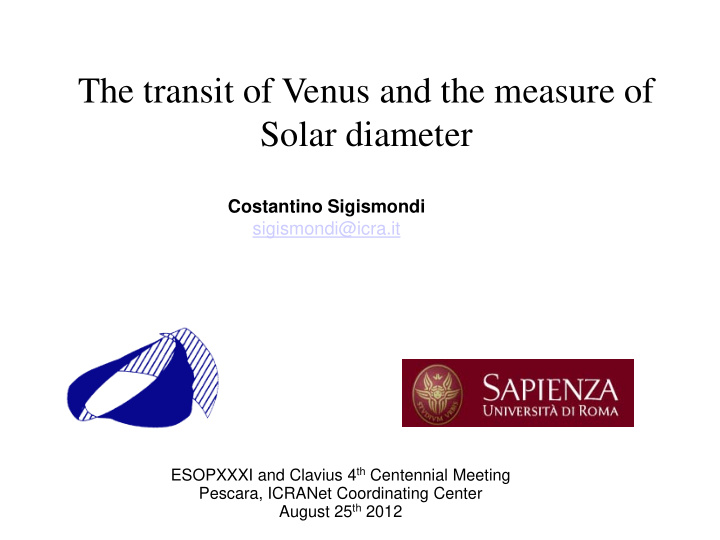



The transit of Venus and the measure of Solar diameter Costantino Sigismondi sigismondi@icra.it ESOPXXXI and Clavius 4 th Centennial Meeting Pescara, ICRANet Coordinating Center August 25 th 2012
Solar oblateness: better measurement from RHESSI (2008) correspondant to J2=10 ¯ ⁷ → Mercury perihelion δθ = 0.02 arcsec/cy; 42.98 arcsec/cy are all relativistic. The problem of reference diameter is crucial for solar physics and Earth's climate: Does it change or not?
Mercury transits and solar diameter from Gilliland 1981
SOHO 2003/2006 and SDO 2012
SDO radial PSF
1631-1639: test for ephemerides 1631: Gassendi sees the first transit of Mercury, but not Venus 1639: Horrocks and Crabtree observed the last phase of the first transit of Venus
1761-1769 AU, black drop & white arc: first global science project
1874-1882 at the dawn of photography era
2004: educational transit Large arrow (solar angular diameter): 567 pixels Smaller arrow (Venus parallax = 2 α ): 8 pixels 567 px → 0,53° (08/06/2004) 8 px → 2 α=0,0035° (12,6'')
2004: science
2012: Venus twilight
Kepler HST RHESSI (solar diameter)
2012: Venus transit and solar diameter Italia-China-France collaboration Huairou Solar Observing Station
2004, Athens: 50 images Hα, 256 level of intensity Internal contacts: 2 nd @ 7 am ± 8 s (low Sun, turbulence) 3 rd @ 1 pm ± 1 s ΔR=0.69 ±0.38 arcsec 2012, HSOS: 2000 images, 4096 levels @ 630+/- 10nm, photosphere; 2000 images Hα at 256 levels ΔR=??? ±0.01 arcsec
Recommend
More recommend